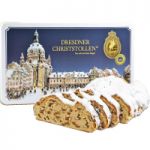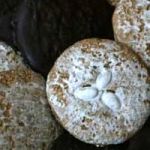 |
A German Christmas Fairytale
As you wander through the many traditional Christmas markets, discover a piece of German hospilitality. Sniff the aroma of freshly roasted almonds and gingerbread spices. Warm your hands and your heart with a hearty swig of mulled wine and let yourself be enchanted by the sound of christmas trumpets and choirs.
In Germany, Christmas is symbolized by the famous stollen, a traditional holiday bread that derives from a tradition more than 500 years old. Stollen are traditionally made from the end of September until the end of December. They are a breakfast fruit bread, filled with marzipan, served either hot or cold. The pleasure of stollen is even greater the second day at breakfast explains Bernd Kütscher, when you bite into a toasted slice, slathered with butter! There are numerous varieties of stollen, including one that looks like a large filled crêpe. In fact, it's a cake studded with rum-soaked candied fruits, filled with almond cream and folded over to enclose the filling. This particular variety symbolizes the baby Jesus wrapped in his swaddling clothes. If you ask bakers in Dresden for their recipe, they won't tell you. What they will say is that you'll need the finest candied fruits and nuts, the freshest eggs and butter for this holiday sweet bread.
But Gourmetpedia knows the secret! Click here for the recipe! (see below)
Glühwein (Mulled Wine)
At Christmas many German town centers have street markets with stalls selling cookies, arts and crafts, wooden toys and other festive items. Almost every street corner seems to boast Bratwurst and Glühwein stalls. It's amazing how revived one can feel after a small glass of warm, spicy red wine. This is a basic recipe, but in Germany, stalls will offer you additional flavorings such as elderberry cordial or a shot of dark rum. Heat your Glühwein in a large saucepan on the stove or in a large jug in the microwave, but don't let it boil or the alcohol will evaporate.

Nothing says Christmas in Germany better than its charming, quintessential Christmas markets that decorate the country during this magical time of year. With a history that dates back almost 600 years ago, Dresden Christmas Market, also known as Striezelmarkt, is the oldest and certainly one of the best Christmas fairs in Germany. It befalls each year at the end of November in the city’s baroque Old Town, with the imposing Church of Our Lady as its backdrop. Highlights include the Stollen Festival and plenty of Saxon culinary delights.
Nestled in the charming, beautifully decorated Old Town of Annaberg-Buchholz, this is one of the loveliest and most authentic Christmas markets in Erzgebirge (Ore Mountains). Visitors have the chance to indulge in all sorts of Christmas mouthwatering regional foods such as potato pancakes, stollen, chubby sausages, and of course the ubiquitous gluehwein (mulled wine).

An original German Christmas specialty, a soft, cake-like nut cookie with a very high degree of nut content and a low flour content.
The production of Lebkuchen dates back to the Middle Ages, formerly produced by German monks in Frankonia, in Bavaria, the region around Nuremberg. Elisenlebkuchen have been known since 1808 and are named after the wife of a Bavarian Count. As the tradition calls for it, you can find the Lebkuchen either coated with rich, dark chocolate or sugar glazed. on wafers soft freshly made.
Christmas Stollen - Christmas cake
Iced Christmas Stollen with Chocolate Ginger Sauce and Warm Dried Fruit Purée
Christmas with Johann Lafer
Number 1 on the german TV cooking show.
Melanie introduces us to the famous stollen, straight from Stollenbaëcker,
the best of Germany's stollen bakeshops…
winner of the Stollen-Oscar in 1999, 2000 and 2001!

-

 Recipes
Recipes
-

 Products
Products
-

 Entertaining
Entertaining
-

 Chefs
Chefs
-

 Hints & Tips
Hints & Tips
-

 Glossaries
Glossaries








